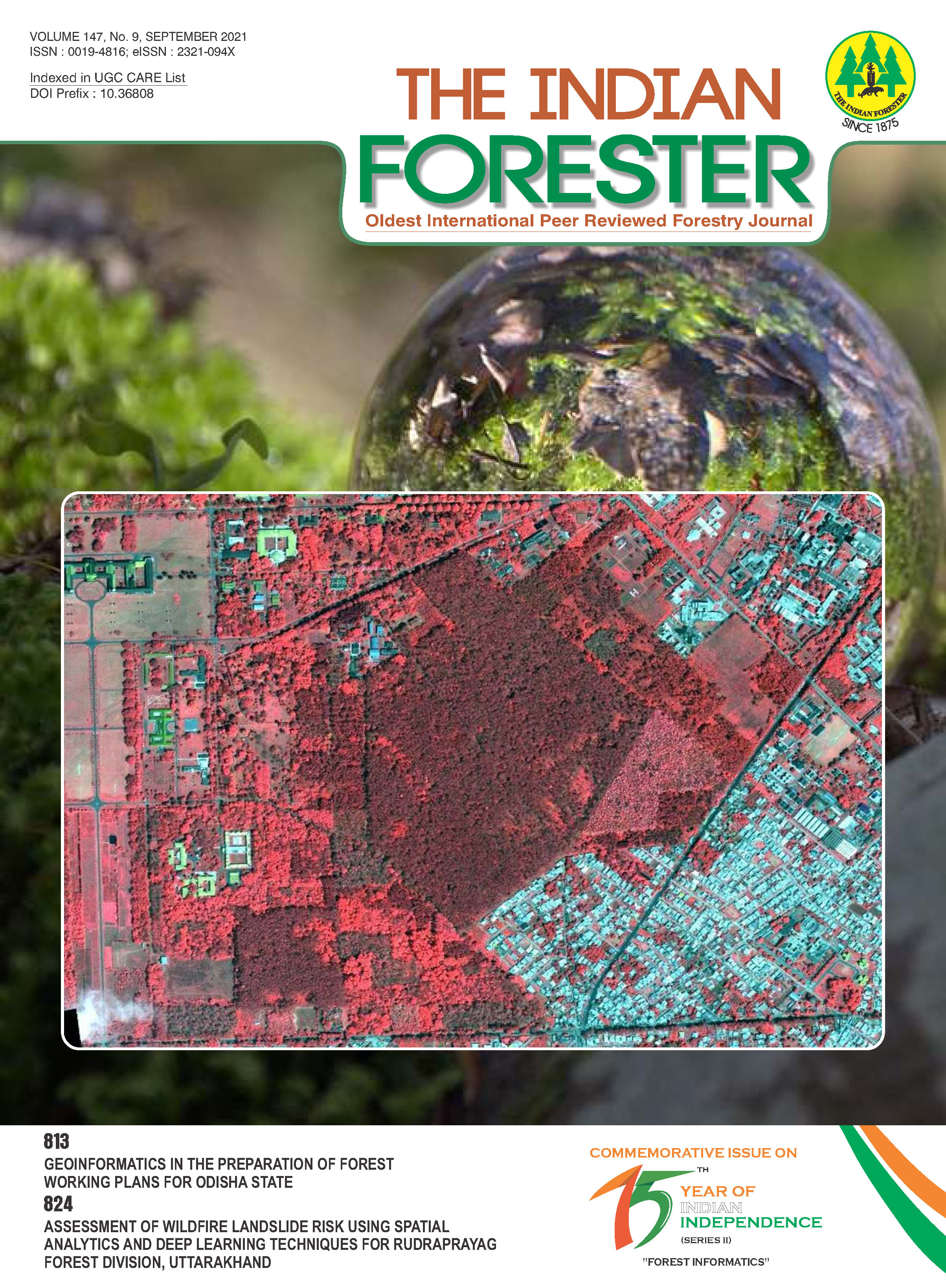Assessment of Wildfire Landslide Risk using Spatial Analytics and Deep Learning Techniques for Rudraprayag Forest Division, Uttarakhand
DOI:
https://doi.org/10.36808/if/2021/v147i9/165509Keywords:
Wildfire, Landslides Risks, Deep Learning, Remote Sensing, GIS.Abstract
Rudraprayag Forest Division of Uttarakhand State in India has a rich biodiversity; however, it experiences high frequency of wildfire incidents every year. According to Forest Survey of India, a total of 2609 Fires were recorded during the last one decade. Also, 1893 Landslides were detected by ISRO, and over 327 Landslides were recorded by Geological Survey of India during 2013-15. Wildfires are known to harm not only trees and plants, but they also decrease water retention capacity of topsoil leading to higher rainfall runoff resulting in significant erosion and debris flow. This attributes to potential causes for land sliding activity and flash floods. In this paper, we attempt to assess relation between wildfires and landslide hazards using GIS based spatial data sciences and subsequently deep learning techniques to identify sub-basin-wise landslide prone areas post wildfire incidents in the Mandakini valley, Uttarakhand. Freely available Landsat 8/Sentinel 2 Imagery, SRTM/ASTER DEM, Landuse/Landcover data were used along with near live feeds from MODIS and NASA. Analysis was carried out using Esri ArcGIS Pro and Python Scripts in Jupyter Notebook. In the study area, about 63-69% landslides were observed near forest fires suggestive of role of wildfires in triggering landslides. Many landslides were observed near roads and drainage establishing that landslides in the region are not only correlated to fire occurrences but are also influenced by other factors. The current study protocol may be used to detect wildfire generated landslide hazards in other areas for developing site specific disaster management plan in the identified susceptible watersheds.References
Anbalagan (1992). Landslide hazard evaluation and zonation mapping in mountainous terrain. Engineering Geology: 32: 269-277.
Carrara A., Guzzetti F., Cardinali M. and Reichenbach P. (1999). Use of GIS technology in the prediction and monitoring of landslide hazard, Natural hazards, 20: 117- 135.
Chuvieco E., Aguado I., Yebra M., Nieto H., Salas J., MartÃn M.P., Vilar L., MartÃnez J., MartÃn S. and Ibarra P. (2010). Development of a framework for fire risk assessment using remote sensing and geographic information system technologies. Ecol. Modell. 221: 46–58.
FSI (2011). Forest types of India. Forest Survey of India, Ministry of Environment, Forest and Climate Change, Government of India, Dehradun.
Garg J.K, Murthy T.V.R., Kimothi M.M. and Singh T.S. (2001). Environmental Hazard Zonation and Optimal Resources Use in the Alaknanda Valley, Garhwal Himalaya using Remote Sensing and GIS Techniques.
Joshi S., Garg J.K. and Amarjeet K. (2021). Automation of Forest Fire Detection and Burnt Area Assessment using integrated GIS with Advanced Spatial Data Sciences for the Rudraprayag Forest Division, Uttarakhand. Indian Forester, 147(3) : 261-266.
Joshi S., Garg J.K. and Kaur A. (2020). Multi-Hazard Risk Zonation based on functions responsible for Hazards like Landslides, Floods, Forest Fires and Earthquakes in Mandakini Valley, Int. J. Recent Technol. Eng., 8(5): 3874–3885.
Kumar M., Singh H., Pandey R., Singh M.P., Ravindranath N.H. and Kalra N. (2019). Assessing vulnerability of forest ecosystem in the Indian Western Himalayan region using trends of net primary productivity. Biodivers. Conserv., 28: 2163–2182.
Napoli D., Marsiglia P., Martire D., Ramondini M., Ullo S.L. and Calcaterra D. (2020). Landslide Susceptibility Assessment of Wildfire Burnt Areas through Earth-Observation Techniques and a Machine Learning-Based Approach. Remote Sens., 12, 2505. https://doi.org/10.3390/rs12152505
Rawat M.S., Uniyal D.P., Dobhal R., Joshi V., Rawat B.S., Bartwal A., Singh D. and Aswal A. (2015). Study of landslide hazard zonation in Mandakini Valley, Rudraprayag district, Uttarakhand using remote sensing and GIS. Current Science, pp 158-170.
Rengers F.K., McGuire L.A., Oakley N.S., Kean J.W., Staley D.M. and Tang H. (2020). Landslides after wildfire: initiation, magnitude, and mobility. Landslides 17: 2631–2641. https://doi.org/10.1007/s10346-020-01506-3.
Sharma N. and Singh R.B. (2017). American Geophysical Union, Fall Meeting, abstract #NH43C-03.
Wang Q., Wenping L., Wei C. and Hanying B. (2015). GISbased assessment of landslide susceptibility using certainty factor and index of entropy models for the Qianyang County of Baoji city, China, J. Earth Syst. Sci., 124 (7): 1399-1415.
Downloads
Downloads
Published
How to Cite
Issue
Section
License
Unless otherwise stated, copyright or similar rights in all materials presented on the site, including graphical images, are owned by Indian Forester.





